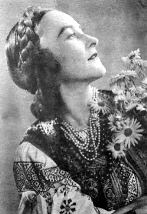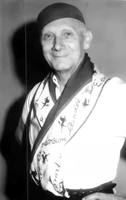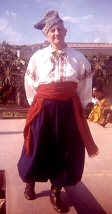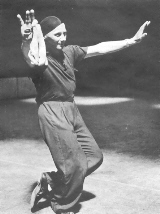|
Anatol Joukowsky and Yania Wassilieva
|
|
CLICK AN IMAGE FOR LARGER VIEW
Anatol Joukowsky, known affectionately as "Mr. J," was born in Poltava, Ukraine, on August 18, 1908, to Ukrainian parents. His father was a colonel in the cavalry of Emperor Nicholas II. Anatol was a teenager during the Russian Revolution when his father was an officer in the Monarchy's White Army in its doomed stand against the communist Red Army. After World War I, Anatol's family settled in Salonika, Greece. His parents wanted him to have a Slavic education, so he attended military school in Belgrade (Beograd), Yugoslavia. It was in Belgrade that the ballet master of the State Theatre suggested that Anatol should have dance lessons. At the age of 15, he began a two-year term of ballet study at Mme. Poliakoff's ballet school. His interest grew, and when Pavlova visited a school performance, she singled him out for special commendation. This aided materially in his decision to make dance a career, and he went on to the State Theater School in Beograd, a four-year institution where each student studied opera, drama, and music.
At the State Theater School, if the student's interest was primarily in dance, he studied eleven different phases, including history of dance, history of costume, dance technique (ballet, character or ethnic, partner support or pas de deux, and dance plastic, which is like modern dance). In the third year of Theater School, each student began training in choreography, staging and stage design, lighting, spacing, and stage history. Dance technique courses were continuous throughout the four years. During their term at the school, students were expected to perform in the theater as background for large dance numbers, processionals, etc. After graduating, students went to work in the State Theater, with dancers beginning in the last row of the corps de ballet for two years. Anatol was a solo dancer for two years and, in 1935, became ballet master and choreographer for the State Theater. Concurrently, with his time at the State Theater School, he studied engineering at the University of Belgrade.
At first, during his two-month vacation period, Anatol would hunt, fish, and watch the people dance in the Yugoslavian countryside at weddings, festivals, and holiday occasions. Between 1923 and 1941, he and a group of friends traveled to Bulgaria, Greece, Hungary, North Africa, Poland, Romania, Spain, Syria, and Turkey. Many of his dance research trips were accomplished on horseback. Anatol graduated in 1926.
 During his fourth year at State Theater School, Anatol was smitten with a slight young woman with long braids that he delighted in pulling -- one Yania Wassilieva. Yania was born on October 24, 1911, in Warsaw, Poland. After World War I, Yania's parents emigrated to Yugoslavia where she began her ballet training. Yania made her dance debut at the National Theater in 1930, and soon became a prima ballerina. Anatol and Yania were married in 1932.
During his fourth year at State Theater School, Anatol was smitten with a slight young woman with long braids that he delighted in pulling -- one Yania Wassilieva. Yania was born on October 24, 1911, in Warsaw, Poland. After World War I, Yania's parents emigrated to Yugoslavia where she began her ballet training. Yania made her dance debut at the National Theater in 1930, and soon became a prima ballerina. Anatol and Yania were married in 1932.
During 1936, Anatol organized a small professional group to specialize in ethnic dance. The group worked on dances Anatol brought back from his many trips to Bulgaria, France, Greece, Macedonia, Poland, Russia, Serbia, and the Ukraine. The dancers had their own musicians and orchestrated their own tunes. They gave their first recital of ethnic dance in 1937 at the University Auditorium of Beograd. They were invited to perform at a Sokol festival in Prague, Czechoslovakia, in 1938, where his performers won the first prize in the competition. He was not only permitted but encouraged by the director of the State Theater to repeat the performance under its auspices. In March 1941, his first exhibition of ethnic dances at the State Theater of Belgrade was presented. It was entitled The Book of Yugoslavia and provided the impetus for two ballets that Anatol choreographed. His works were enormously well received in Belgrade.
During this period, Yania was an active participant in many of the performances, and in the scientific hunts which took them into the native hills and countrysides to find authentic dances, notate music, and photograph the people in their native costume.
 In the interim between World War I and II, Anatol was the only professional choreographer who was doing folk dance research, and this was the last era when these dances could be found alive in these particular countries. He would hear news of an upcoming wedding in some small village (in Romania, Yugoslavia, Bulgaria, etc.) and would trek to it knowing quite well that there would be lots of music and dancing. In addition to his many accomplishments, he was awarded the Cavalier Cross of Bulgaria from King Boris III in 1938, the Order of St. Vladislav of Czechoslovakia from President Benes in 1938, and the Order of St. Sava from prince Paul of Yugoslavia in 1941.
In the interim between World War I and II, Anatol was the only professional choreographer who was doing folk dance research, and this was the last era when these dances could be found alive in these particular countries. He would hear news of an upcoming wedding in some small village (in Romania, Yugoslavia, Bulgaria, etc.) and would trek to it knowing quite well that there would be lots of music and dancing. In addition to his many accomplishments, he was awarded the Cavalier Cross of Bulgaria from King Boris III in 1938, the Order of St. Vladislav of Czechoslovakia from President Benes in 1938, and the Order of St. Sava from prince Paul of Yugoslavia in 1941.
As the specter of war loomed in Europe, Anatol and Yania fled to Austria, where he became ballet master at the Vienna Opera House. He was captured and sent to a prisoner-of-war camp in Berlin, Germany, for a time but escaped, found Yania, and made his way to France toward the end of the war. He returned to ballet in the French theater and later stayed in Belgium. He joined the French 5th Armored Division by the Rhine in 1945 and enrolled himself and Yania for the American quota to come and live in the United states (he had a sister in San Francisco). At the end of World War II, Yania performed with Anatol in programs staged by the Special Services Division of the French Army. In 1948, while waiting to be included in the American immigration quota, he and Yania obtained positions with Colonel de Basil of the Ballet Russe, which was playing in France. He traveled with the troupe to Africa, Portugal, and Spain. While with the the company, he danced, choreographed, and was a second stage director for two years. Anatol had now danced in nearly every country in Europe and the Middle East. When Ballet Russe disbanded, he obained a position in the Belgian Royal Opera Ballet.
 In January of 1951, Anatol and Yania arrived in New York City, New York, through Canada. Anatol's first job was a machinist for Apparel City in San Francisco. He also worked for United Airlines. That same year, the couple gave a two-person dance recital at a Legion of Honor Hall and were soon energizing the folk dance community. Later they moved to San Francisco, where he started to teach in the San Francisco Ballet (14 years), the San Francisco Conservatory of Music and College, and part-time in universities. He finally obtained a full-time position with San Francisco State College.
In January of 1951, Anatol and Yania arrived in New York City, New York, through Canada. Anatol's first job was a machinist for Apparel City in San Francisco. He also worked for United Airlines. That same year, the couple gave a two-person dance recital at a Legion of Honor Hall and were soon energizing the folk dance community. Later they moved to San Francisco, where he started to teach in the San Francisco Ballet (14 years), the San Francisco Conservatory of Music and College, and part-time in universities. He finally obtained a full-time position with San Francisco State College.
In 1953, Anatol decided to expand his dance recital from a duo to a full-fledged show comprised of members of the various classes that he was teaching. "The Joukowsky Recital" became one of the high points of the close of "Kolo Week" in San Francisco.
In 1963, Anatol taught special classes in the Russian folk form at Stanford University and led various exhibition groups. He became active in the Folk Dance Federation of California, teaching workshops, conferences, and camps, including the annual Stockton Folk Dance Camp in the north and the Santa Barbara Folk Dance Conference in the south (1963 and 1964). In the late 1960s, he also taught ethnic dance at San Francisco State College (before the designation was changed to University).
Long-time friend and federation member Ruth Ruling worked with Anatol, describing notes for the dances he taught and performed. Those descriptions became the basis for his book, The Teaching of Ethnic Dance, published in 1965.
Anatol and Yania lived for a time in East Palo Alto where Yania operated a dance studio for a number of years. They later moved to Menlo Park. Anatol's death of heart illness on October 5, 1998, preceded his beloved Yania's death on September 17, 1999, by less than a year. The couple had no children.
Among Professor Joukowsky's publications and articles are
- "Ajde Jano: A Serbian Folk Song." Viltis. XVI (1957), 10.
- The Teaching of Ethnic Dance. J. Lowell Pratt and Company, New York, New York, 1965. 190p.
Dances Anatol taught include A Ja Zo Šariša (A Ja Tzo Saritsa), Ajde Jano, Bandura Kozachok, Barynya, Bavno 0ro (Makedonsko 0ro), Bella Franca (Sardana), Bird's Choir Hora, Bolen Leži Mlad Stojane, Branle a' Six, Brâul from Gorj, Bunjevačko momačko kolo, Căluș Dance from Gorj (Calușarii), Čamče (Čamčeto), Čardáš z Košických Hámrov, Čarlama užicka (Užicka čarlama), Daičevoto, Dajčovo horo (Zizaj nane), Dačovo horo III, Dakota (Sioux) Social Dance, Detva čardáš, Dilindaro (Pravo horo), Djebel Aissa, Dodecanesian Ballos, Doiransko oro, Dunda kolo, Ergensko oro, Fatiše kolo (Kolo from Vranje), Ferhat, Furiant, Gankino horo, Gerakina, Horă din Banat, Horă din Maramureș, Horehronsky Čardáš, Hultzulka, I Kto Evo Znaiet? (Who Knows?), Jablochko (Little Apple), Jambolska lesa, Jokul Moldovanesc, Kabardinka, Kak u Kluchika (By a Spring), Krad Csárdás, Karagouna, Karanfile, Katanka, Katia (Nashey Kate, Our Katia), Kedves Csárdás, Kolo from Šumadija, Kolo iz Vranje, Komitsko oro, Krakowiaczek, Krakowiak, Krakowiak Po Truikam, Krakowiak Polessky, Kukułeczka, Kutzovlaško, Lesnoto, Lesnoto oro (Lesnoto), Makedonsko oro, Marfuta, Medgidia Sârba, Metelikum, Momačko kolo, Nitrianski Tanz, Oberek Opoczynski, Oberek Zvičainy, Oj ti mome, Orlovskaya (Dance from Orel), Osetenian Lezginka, Pravo horo (Dilindaro), Pima Harvest Dance (Indian Harvest Dance), Pod Borem (Krakowiak), Politiko Hasapiko, Polonez, Polonez od Beskids, Polonez Warszawski, Prekid kolo, Rŭčenica, Rudnički čačak, Russian Quadrille (Quadrille Polka), Sârba, Seljančica, Senjačko kolo, Serbian Medley, Serbian Medley III, Šestorka (Kola iz Šumadija), Slavonski drmeš, Stara Dunda, Staro ratarsko, Staro svadbarsko, Što mi e milo, Timonia, Tingi Lingi, Trepák, Turopolski drmeš, Un Pied Dans l'Eau, Unverdos, V Lesu Prifrontovom (In the Forest), Vranjanka, Vranjsko kolo, Vrtielka Čardáš, Yablochko, Za Pojas, Žabarka, Zaspala Jana Janinka, and Zarajče mi.
